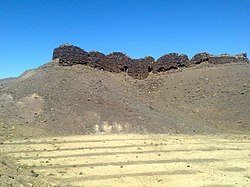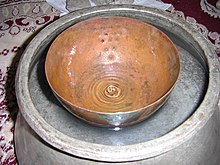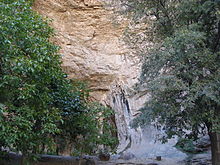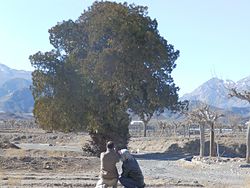Zibad
This article mayrequirecleanupto meet Wikipedia'squality standards.The specific problem is:Gallery is a mess.(March 2021) |
Zibad
Persian:زيبَد | |
|---|---|
Village | |
 Shelter of the last emperor of sasanianIran,Yazdegerd III | |
| Coordinates:34°16′35″N58°29′14″E/ 34.27639°N 58.48722°E[1] | |
| Country | Iran |
| Province | Razavi Khorasan |
| County | Gonabad |
| District | Kakhk |
| Rural District | Zibad |
| Established | 200BC |
| Population (2016)[2] | |
| • Total | 1,058 |
| Time zone | UTC+3:30(IRST) |
| Area code | 0511 |
Zibad(Persian:زيبَد)[a]is a village in, and the capital of,Zibad Rural District,ofKakhk District,Gonabad County,Razavi Khorasanprovince,Iran.[4]
Demographics
[edit]Population
[edit]At the time of the 2006 National Census, the village's population was 868 in 288 households.[5]The following census in 2011 counted 856 people in 309 households.[6]The 2016 census measured the population of the village as 1,058 people in 397 households. It was the most populous village in its rural district.[2]
Zibad, which means beautiful in Persian, was a famous ancient area inShahnameh.According toShahnameh Ferdowsi(around 1000 AD), it was the place of a famous war calledDavazdah Rokh(12 hero) betweenIranandTuran.Zibad also has an ancientqanatthat may be more than 1600 years old.

Zibad famous products and sites
[edit]- itssaffron,watermelon, melon, rice and in the past alsoopiumproduction.
- its ancient castle which was the shelter of the last emperor of sasanianiran,Yazdegerd III,the place of three ancient wars, and itsMithraismmonument.
- its Qanat and dar e soufe, a famous mountain rock wall, similar toTaq-e Bostan
- its water clock which had been in continuous use from 400BCE until 1950.
- ItsWatermill,producing flour and cracked wheat. The ancient water mill was at work until 1984 and destroyed for the construction of a dam.


According toCallisthenes,the Persians were usingwater clocksin 328BCE to ensure a just and exact distribution of water from qanats to their shareholders for agricultural irrigation. The use of water clocks in Iran, especially in Zibad, dates back to 500BCE. Later they were also used to determine the exact holy days of pre-Islamic religions, such as theNowruz,Chelah,orYaldā- the shortest, longest, and equal-length days and nights of the years. The water clocks used in Iran were one of the most practical ancient tools for timing the yearly calendar.[2] .[7]
Kūh-Zibad
[edit]ThemountainofKūh-Zibadis located near Zibad, and is the second-highest mountain inRazavi Khorasan Province. Kūh-Zibadis famous because of some great historical events. Its peak is called Tir Mahi. The terrain around Kuh-e Zibad is mainly hilly. The highest point in the vicinity is 2,775 meters (9,104 ft) above sea level, 17.7 km (11.0 mi) southeast of Qole-e Tir Mahi. Around Kuh-e Zibad is very sparsely populated, with 5 inhabitants per square kilometre. Nearest society Zibad, 8.5 km (5.3 mi) north of Kuh-e Zibad. The neighbourhood around Kuh-e Zibad is barren with little vegetation. In the neighbourhood around are unusually many named mountains and valleys. A cold steppe climate prevailing in the region. The average annual temperature in the area is 17 °C. The warmest month is July when the average temperature is 30 °C, and the coldest is January, with 1 °C. Average annual rainfall is 211 mm (8 in). The rainiest month is February, with an average of 58 mm (2 in) of precipitation, and the driest is July, with 1 mm of precipitation. This mountain had been referred in some historical book such asshahnamehinDavazdah Rokhwaras the Zibad mountain and its eastern part is called black mountain or kouh Gonabad. the long-range mountain called Qohestan and It extends fromBajestantoBirjandnear the border withAfghanistanthis rang mountain separatesouth KhorasanfromRazavi Khorasan,part of this rang mountain nearKakhkis called black mountain or Kouh eGonabad
Zibad Castle
[edit]Zibad Castleis one of the four historical monuments of Zibad. It is located inGonabadand is believed to be the last shelter of the last Sasanian emperorYazdegerd III.It was registered in 2001 as an Iranian national heritage property, as it is related to the history of pre-IslamicIran.There is the royal castle nationally registered in 2002 under the name of Shahab Castle. Sources conflict as to the exact manner of the emperor's final moments. One suggests that after his defeat, he sought refuge at a mill nearMarv,the latter who killed Yazdegerd in order to obtain his jewelry.[8]The Cambridge History of Iranstates that the miller was sent byMahoe Suri.[9]According to the history of Belazari,Yazdegerd IIIwas defeated in a war in the city of Gonabad.
According to the excavations of Zibad-Gonabad Fortress and according to oral narrations and the report of Blazeri and Habib Abdolhai,Dr Ajam and Abas Zmani (historical study magazine 1974), it seems that the narration related to the murder of Yazdgerd inMerwMill is more mythical than fact. What is closer to the truth is the narration ofAl-BaladhuriinKitab Futuh al-Buldan,that he was killed in Gonabad.
The main text of Blazeri's book The Fate of Yazdgerd III:
Then he went to Khorasan, then he went to Janabad (Gonabad) he was welcomed and ruler of Merv send Nizak Trkhan to welcome him in Gonabad. but after weeks he asked the emperor to marry his daughter and the emperor refused and this caused a war and at the end Nizak defeats the king's army and destroys and captures remnants of the imperial forces. The battle occurred in ZibadGonabad.[10] Mahoe Suriwas probably from theHouse of Suren,one of theseven Parthian clansof the Sasanian state.[9]During theIslamic invasion of Iran,Yazdegerd III went to refuge inMarv;on his way to Merv he stayed in Gonabad Mahoe. The envoy warmly received them.[11]Mahoe Suriused opportunity to secretly plot with theHephthaliteruler Nizak against Yazdegerd.[9]
Regardless, the death of Yazdegerd marked the end of the Sasanian Empire, and made it less difficult for the Arabs to conquer the rest of Iran. All ofKhorasanwas soon conquered by the Arabs, who would use it as a base toattack Transoxiana.[8]The death of Yazdegerd thus marked the end of the last pre-Islamic Iranian empire after more than 400 years of rule. An empire–which had a generation earlier briefly conqueredEgyptandAsia Minor,evenreaching as a far as Constantinople,fell to a force of lightly equipped Arabs that were used to skirmishes and desert warfare. The heavy Sasanian cavalry was too sluggish and systematized to contain them; employed light-armed Arab or East Iranian mercenaries from Khorasan and Transoxiana would have been much more successful.[12]
Sights and attractions
[edit]


Zibad is an ancient place with many historical places. TheDavazdah Rokhwar had occurred in Zibad.
Sufeh Pir
[edit]Sufeh Pir is another famous place in Zibad, a holy cave believed to be the tomb ofPiran Visehin theKūh-Zibadmountain. He is aTuranianfigure inShahnameh,thenational epicofGreater Iran.Beside Shahnameh, Piran is also mentioned in other sources such asTabariandTha'ālibī.He is the king ofKhotanand thespahbedofAfrasiab,the king of Turan.
According to the book of Dr. Abas ZamaniPiran Visehwas buried in the cave of Sofe Zibad now called DarSufa Pir.[3]
Sarv-e Zibad
[edit]TheCypress of Zibad(Persian:سرو زیبدSarv-e Zibad), is aCupressus sempervirenstree in Zibad, Sarv-e Zibad is 10 km (6.2 mi) from[4]Qanats of GhasabehaUNESCO'sWorld Heritage Sitessince 2016,.[13] Sarv-e Zibad is protected by theCultural Heritage Organization of Iranas a national natural monument and is a major tourist attraction with a height of 20 metres and with a perimeter of 6.5 meters (21 ft) at its trunk and 16 meters (52 ft) higher up around its branches. It is estimated to be over two millennia old and is likely the second-oldest living lifeform inIran. The exact age of the tree has been difficult to determine, but it is estimated to be between around 2000 years old. Despite the desert and dry place with little rain natural conditions of its location have been credited as the main reason for the tree's longevity.[5].[14](Persian:سرو زیبد) Sarv Zibad is 1 km (0.62 mi) fromDavazdah Rokhbattle field near to theKūh-ZibadandZibad Castleit was center of ancient Zibad and now located north of the central roundabout of Zibad.
Culture
[edit]
Holding the Yalda Night and festival ofDavazdah Rokhis 2 most famous festival of Zibad. Iranian festivalssuch asYaldā NightandNowruzare celebrated in Zibad.
See also
[edit]- Davazdah Rokh
- Gonabad
- Kūh-Zibad
- Razavi Khorasan Province
- Zibad Castle
- List of oldest trees
- Cypress of Kashmar
- Sarv-e Abarkuh
- Qanat
- Davazdah Rokh
- Kay Khosrow
See also
[edit]![]() Media related toZibadat Wikimedia Commons
Media related toZibadat Wikimedia Commons
Gallery
[edit]-
Zibad Castle
-
qanat zibad
-
mountain
-
castell
-
saffron
-
.Rheum zibad
-
zibad
-
Kūh-ZibadZibad Gonabad
-
castell
-
Zibad Castle
-
Yalda festival
-
Ancient water clock
-
Ancient water clock.
-
12rokh war paintings
-
12rokh war paintings
-
Davazdah Rokhwar paintings
-
Davazdah Rokhpaintings
-
12rokhDavazdah Rokhpaintings
-
zibad
-
zibad
-
zibad
Notes
[edit]References
[edit]- ^OpenStreetMap contributors (29 April 2023)."Zibad, Gonabad County"(Map).OpenStreetMap(in Persian).Retrieved29 April2023.
- ^ab"Census of the Islamic Republic of Iran, 1395 (2016)".AMAR(in Persian). The Statistical Center of Iran. p. 09. Archived fromthe original(Excel)on 2 April 2022.Retrieved19 December2022.
- ^Zibad can be found atGEOnet Names Server,atthis link,by opening the Advanced Search box, entering "-3089466" in the "Unique Feature Id" form, and clicking on "Search Database".
- ^Mousavi, Mirhossein."Creation and formation of seven rural districts including villages, farms and places in Gonabad County under Khorasan province".Lamtakam(in Persian). Ministry of Interior, Council of Ministers. Archived fromthe originalon 7 January 2024.Retrieved7 January2024.
- ^"Census of the Islamic Republic of Iran, 1385 (2006)".AMAR(in Persian). The Statistical Center of Iran. p. 09. Archived fromthe original(Excel)on 20 September 2011.Retrieved25 September2022.
- ^"Census of the Islamic Republic of Iran, 1390 (2011)".Syracuse University(in Persian). The Statistical Center of Iran. p. 09. Archived fromthe original(Excel)on 20 January 2023.Retrieved19 December2022.
- ^conference of Qanat in Iran - water clock in persiaد1383[1]آفتاب
- ^abKia 2016,p. 285.
- ^abcZarrinkub 1975,p. 25.
- ^فتوحالبلدان،Al-BaladhuriinKitab Futuh al-Buldanp569 صص ۵۶۸–۵۶۹
- ^Pourshariati 2008,pp. 261–262.
- ^Shahbazi 1986,pp. 489–499.
- ^The Persian Qanat
- ^M.Ajam, mohammad."Sarv zibad".Baran. Archived fromthe originalon 27 February 2021.Retrieved6 March2021.
Bibliography
[edit]- Kia, Mehrdad (2016).The Persian Empire: A Historical Encyclopedia [2 volumes]: A Historical Encyclopedia.ABC-CLIO.ISBN978-1610693912.
- Pourshariati, Parvaneh (2008).Decline and Fall of the Sasanian Empire: The Sasanian-Parthian Confederacy and the Arab Conquest of Iran.London and New York: I.B. Tauris.ISBN978-1-84511-645-3.
- Shahbazi, A. Shapur(1986). "Army i. Pre-Islamic Iran".Encyclopaedia Iranica, Vol. II, Fasc. 5.London et al. pp. 489–499.
{{cite encyclopedia}}:CS1 maint: location missing publisher (link) - Zarrinkub, Abd al-Husain (1975). "The Arab conquest of Iran and its aftermath".The Cambridge History of Iran, Volume 4: From the Arab Invasion to the Saljuqs.Cambridge: Cambridge University Press. pp. 1–57.ISBN978-0-521-20093-6.
- [6]
- Parssea magazine[7]
- IRNA news agency[8]
- Baran Kavir magazine No 62 Sarve Zibad Dr.M.Ajam[9]Archived27 February 2021 at theWayback Machine
- Sarve in iran[10]
External links
[edit]- "قنات میراث فرهنگی و علمی ایرانیان".Aftabir.Retrieved11 February2019.
- "مرکز پژوهشها - ایجاد و تشکیل تعداد 7 دهستان شامل روستاها، مزارع و مکانها در شهرستان گناباد تابع استان خراسان".Rc.majlis.ir.Retrieved11 February2019.
- Parssea magazine[11]
- IRNA news agency[12]



























